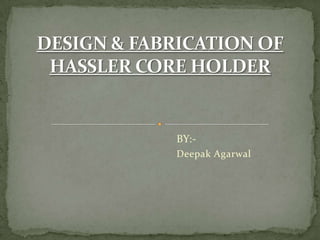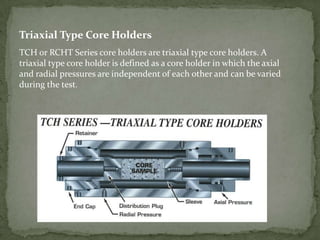Core holders
- 2. ï Core Holder ï Need Of Core Holder ï Tests Performed By Core Holder ï Types Of Core Holders ï Standard Core Holders In Industry ï Hassler Type Core Holder ï Construction ï Working ï Preceding Of The Project So FarâĶâĶ. ï References & Bibliography
- 3. ï A portable apparatus provide on-site permeability measurements and formation evaluation by a core sample extracted from an underground reservoir. ï CORE SAMPLE: A cylindrical rock(1-1/8â to 5-1/4" diameter and 30 to 60 ft long) sample taken from the formation for geological analysis to perform laboratory evaluation of basic properties.
- 4. ï It is usually desirable for both routine and special tests of core samples to be conducted at pressures simulating those encountered in the subsurface geologic formations from which the core samples were removed. ï The portable apparatus is easily and conveniently transported to well locations for use on-site, thereby allowing the core sample to be tested in actual reservoir conditions.
- 5. ï Gas & Liquid Permeability ï Formation Damage ï Porosity ï Dynamic Filtration ï Compressibility ï Acidization ï Relative Permeability ï Resistivity ï Secondary Water Flooding ï Radial Flooding ï Enhanced Oil Recovery ï Steam Flooding
- 6. ï According to geometry: -Vertical core holder -horizontal core holder ï According to test: -resistivity core holder -polymer flooding core holder -acidizing core holder -Steam Flooding core holder -Dynamic Filtration core holder ï For Permeability Measurements -Gas (or Air) permeability measurement core holder -water (or brine, polymer) permeability measurement core holder
- 8. ï Hassler Type Core Holders ï Biaxial Type Core Holders ï Triaxial Type Core Holders
- 9. Biaxial Type Core holders Biaxial type core holders are defined as core holders that have common radial and axial pressure applied to the core sample. These core holders are routinely used for gas and liquid permeability and other core flooding experiments.
- 10. Triaxial Type Core Holders TCH or RCHT Series core holders are triaxial type core holders. A triaxial type core holder is defined as a core holder in which the axial and radial pressures are independent of each other and can be varied during the test.
- 11. ï Hassler type core holders are defined as core holders that have radial pressure applied to the core sample. ï These core holders are routinely used for gas and liquid permeability and other core flooding experiments. ï Spacers are provided to accommodate undersized cores. ï The distribution plugs are provided with a single inlet and outlet. However, additional ports can be added as required. The volume of all ports and flow lines are kept to a minimum so that accurate flow data can be determined.
- 13. ï An elastic rubber sleeve for receipt of a core sample is disposed in an open-ended, cylindrical cavity of an open- ended, cylindrical body. ï The ends of the sleeve are fitted over flanged ferrules. A cylindrical end plug is releasably locked in one end of the body with one of its ends inserted through the adjacent ferrule engage one end of the core sample. ï A cylindrical piston housing having a cylindrical cavity is releasably locked in the other end of the body. A cylindrical piston is disposed in the cavity of the piston housing with one of its ends protruding from an open end of the cavity and inserted through the adjacent ferrule to engage the other end of the core sample.
- 14. ï Pressurized fluid moves the piston to apply axial force to the core sample. The sleeve is compressed by pressurized fluid to apply radial force to the core sample. Test fluid conduits are provided in the piston and the end plug.
- 15. Fluid is forced into one end of a rock (or soil) specimen under pressure P, and the amount of fluid emerging at the other end per unit time (also called flow rate q) is measured. k A ïp qï― ïL
- 16. ï With this design, the core holder does not need to be completely disassembled in order to interchange core test samples. After the confining pressure has been released, the end plugs and distribution plugs are removed and the core sample is easily removed from the sleeve. The sleeve and end caps remain in place within the core holder. ï Quick release end plugs and quarter turn end plug removal allows for easy assembly and disassembly from one end.
- 17. 1. Core sample may not be representative of the reservoir rock because of reservoir heterogeneity. 2. Core recovery may be incomplete. 3. Permeability of the core may be altered when it is cut, or when it is cleaned and dried in preparation for analysis. This problem is likely to occur when the rock contains reactive clays. 4. Sampling process may be biased. There is a temptation to select the best parts of the core for analysis.
- 18. ï Anderson, G. 'Coring and Core analysis ï Handbook,' Tulsa. Petroleum Publishing Co., 1975. 200 p. ï âDrilling Operations Manualâ IDT ONGC 1994 ï âReservior Engineeringâ by TARAK AHMED ï âMethods and apparatus for permeability measurementâ by G. L. HASSLER patented in 1944.


















